
ORP Błyskawica (Lightning) is a Grom-class destroyer which served in the Polish Navy during World War II. It is the only Polish Navy ship to have been decorated with the Virtuti Militari, Poland's highest military order for gallantry, and in 2012 was given the Pro Memoria Medal. Błyskawica is preserved as a museum ship in Gdynia and is the oldest preserved destroyer in the world. Błyskawica is moored next to the Dar Pomorza.
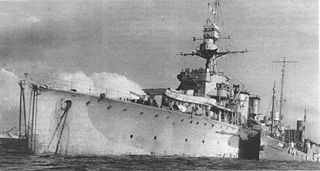
HMS Dragon, also known in Polish service as ORP Dragon, was a D- or Danae-class cruiser built for the Royal Navy. She was launched in Glasgow, in December 1917, and scuttled in July 1944 off the Normandy beaches as part of the Arromanches Breakwater.

HMS Garland, also known by her Polish designation ORP Garland, was a G-class destroyer built for the Royal Navy in the mid-1930s. During the Spanish Civil War of 1936–1939 the ship spent considerable time in Spanish waters, enforcing the arms blockade imposed by Britain and France on both sides of the conflict. Shortly after World War II began, she was badly damaged by the premature explosion of her own depth charges and required over six months of repairs. Before these were completed, Garland was loaned to the Polish Navy in May 1940. The ship was assigned to the Mediterranean Fleet afterwards and escorted convoys there before being assigned to the Western Approaches Command in September for escort duties. She escorted a convoy from Gibraltar to Malta during Operation Halberd in September 1941 and escorted Convoy PQ 16 from Iceland to Murmansk in May 1942. She was badly damaged by a near miss from a German bomber during that operation and required three months of repairs.

USS Fairfax (DD-93) was a Wickes-class destroyer in the United States Navy during World War I, later transferred for World War II service first to the Royal Navy as HMS Richmond (G88), a Town-class destroyer, and then to the Soviet Navy as Zhivuchy.

The first USS Twiggs (DD–127) was a Wickes-class destroyer in the United States Navy during World War I. She was named for Major Levi Twiggs. She was later transferred to the Royal Navy, as HMS Leamington and to the Soviet Navy as Zhguchy, before returning to Britain to star in the film The Gift Horse, which depicts the St. Nazaire Raid.
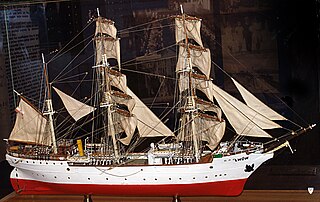
Lwów was the first officially registered Polish sailing-ship. Launched in 1868 in Birkenhead, England, as frigate Chinsura, from 1883 she was named Lucco; then until 1920, Nest. Since 1920 she was under the Polish banner. Named Lwów, after the third biggest city of the Second Polish Republic, she cruised the whole world in the 1920s, being the first ship under Polish banner to have crossed the Equator, during a cruise to Brazil in 1923. She was also the first Polish training ship. Her notable captains included Mamert Stankiewicz.
ORP Gryf was a school and hospital ship of the Polish Navy, a second vessel to bear that name. She was built in German-occupied Denmark as a cargo ship in 1944, shortly before the end of World War II and initially named Irene Oldendorff. Soon after the capitulation of Germany, she was taken by the United Kingdom, passed to the Ministry of War Transport (MoWT) and renamed Empire Contees, but in 1946 it was given to the Soviet Union as part of that country's war reparations from Germany. Renamed Omsk (Омск), she served in the Soviet merchant fleet until 1947 when she was sold to Poland.

ORP Sokół was a U-class submarine built by Vickers-Armstrong at Barrow-in-Furness. Shortly after launching in September 1940 she was to be commissioned by the Royal Navy as HMS Urchin, but instead was leased to the Polish Navy due to a lack of experienced submarine crews. A sister boat to Dzik, both boats operated in the Mediterranean from Malta, where they became known as the "Terrible Twins".

ORP Krakowiak was a British Type II Hunt-class destroyer escort, used by the Polish Navy during World War II. Initially built for the Royal Navy, it bore the name of HMS Silverton during British use.
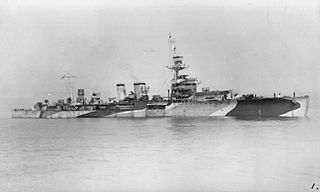
HMS Danae was the lead ship of the Danae-class cruisers, serving with the Royal Navy between the world wars and with the Polish Navy during the latter part of World War II as ORP Conrad.

ORP Ślązak was a World War II Hunt-class destroyer. Initially laid down in 1940 for the Royal Navy as HMS Bedale, in 1942 she was commissioned by the Polish Navy.

MS Batory was a Polish ocean liner which was the flagship of Gdynia-America Line, named after Stefan Batory, the sixteenth-century King of Poland. She was the sister ship of MS Piłsudski. After Allied wartime service, mainly under the UK Admiralty, she became in 1951 the flagship of the Polish Ocean Lines and the Polish merchant fleet. She is often described as the "Pride of the Polish Merchant Marine". Batory along with her sister Piłsudski were the two most popular ocean liners of Poland.

MS Piłsudski was a medium-size ocean liner of the Polish Merchant Marine, named for Marshal Józef Piłsudski, a national hero of Poland.

ORP Mazur was a torpedo boat, then gunnery training ship of the Polish Navy. She was the former German torpedo boat V-105. She took part in the Polish Defensive War and was sunk by German bombers on September 1, 1939, as the first combat ship lost in the war.

The Italian auxiliary cruiser Ramb III was built at Genoa by Ansaldo in 1938.
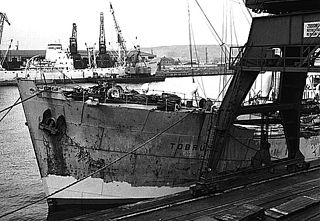
Tobruk was a 7,090 GRT cargo ship which was built in 1941 as Empire Builder by William Gray & Company Ltd for the Ministry of War Transport (MoWT). On completion she was handed over to the Polish government-in-exile and renamed Tobruk. She was a member of a number of convoys during the Second World War. She was sold in 1951 to Polskie Linie Oceaniczne and served until 1967. She was scrapped in 1968.
Wahehe was a 4,690 GRT cargo ship which was built in 1922 as Wadigo by Reiherstieg Schiffswerfte und Maschinenfabrik, Hamburg for Woermann Linie AG. She was converted to a refrigerated cargo liner in about 1934.

The Polish Navy is the naval branch of the Polish Armed Forces. The Polish Navy consists of 46 ships and about 12,000 commissioned and enlisted personnel. The traditional ship prefix in the Polish Navy is ORP.
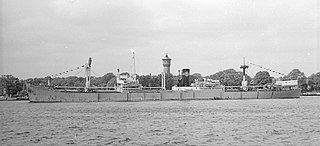
SS Narwik, formerly Empire Roamer, was a Polish general cargo ship built in 1941 to the order of the British government, as one of the Empire B type ships. In 1942, together with four others, it was transferred to the Polish Government in Exile for the Polish Merchant Navy. In Polish service, the name of the ship was changed to "Narwik" to commemorate the Polish contribution to the Battle of Narvik. The transferred ships formally became the property of GAL, but they were chartered to the War Transport Administration. Narwik sailed under the Polish flag to 1972.

SS Paderewski, was a Polish general cargo ship of World War II period, built in 1920 in the USA, but not completed before 1941. She was sold to Gdynia America Line (GAL), and named in honour of the pianist and politician Ignacy Jan Paderewski. She was sunk on 30 December 1942 by the German submarine U-214 near Trinidad, with a loss of three lives.



















